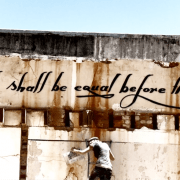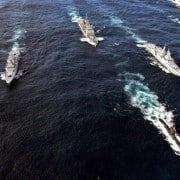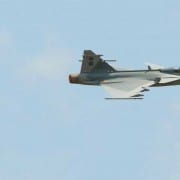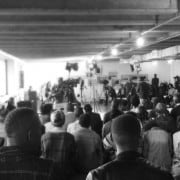|
Getting your Trinity Audio player ready...
|
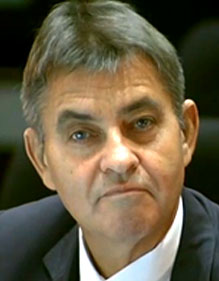 By Lee-Ann Alfreds
By Lee-Ann Alfreds
Whistleblower Richard Young recalled in his second day on the stand the exact moment he realised the irregularities being perpetrated in the arms deal – the beginning of July 1998.
Testifying at the Arms Procurement Commission which is investigating allegations of fraud and corruption in South Africa’s 1999, R71-billion deal, Young – a losing bidder for software in the corvettes – remembered his first inkling that all was not right.
“I remember that meeting extremely well, because if I have to say that my travail [with] the arms deal started at a particular point in time, this is the exact point in time … where I got the first idea that things were not going right and would not be,” he said of the technical committee meeting at Mount Edgecombe in KwaZulu-Natal. Here, African Defence Systems (ADS), part of the successful frigate consortium led by French arms manufacturer Thomson CSF, presented new combat suite architectures which omitted Communications Computer Intelligence Integration (C²I²) Systems’ information management system (IMS). C²I² is Young’s company.
“What I remember is, during these presentations, by ADS… they presented new combat suite architectures. They handed out a whole bunch of diagrams, indicate, they are combat suite architecture one to seven … but they are completely missing of the IMS, in its entirety. Basically, it is replacing it with the Tavitec combat management system,” he recalled.
ADS eventually replaced IMS with its own naval combat system Detexis.
A better offering, but still omitted
Young also testified that an evaluation undertaken in June 1999 on the instructions of the South African navy and the state’s arms procurement company, Armscor, proved C²I²’s system was better than Detexis.
“I never knew about the testing until a year later. We were not informed of the assessment nor invited to send representatives to be present,” Young said. He said the evaluation team identified 16 areas of concern in relation to Detexis and six in relation to IMS and concluded the IMS should be retained.
The evaluation team concluded the IMS was a superior product to the Detexis system, he said.
Young said the Detexis system did not comply with the required specifications listed by the navy but despite this evaluation, navy and Armscor officials decided that IMS should be replaced with the Detexis system.
He said that his company received correspondence from Armscor in August last year saying the Detexis system was not being considered for the naval hydrographic survey vessel to be acquired soon.
Armscor said the system could be regarded as obsolete and not cost-effective, he said. “It is difficult to envisage a more damning indictment of the Detexis Diacerto Databus than this, by the very parties that were responsible for its acquisition.”
Tweaking the figures
C²I² was listed as a candidate supplier to supply the IMS for the corvettes until the main contractor decided Young’s company was a risk, and added a risk fee on to his bid. “There was no risk. The risk was low in all of those categories. So in my view there was no real risk at any level,” he said.
Young testified that he was not complicit in the upward costing of his bid, which led to C²I²’s system being “deselected”. He testified that C²I²’s final quote of R42-million was bumped up to R89-million by ADS without his knowledge.
He did recall that while the R42-million was the final IMS price, ADS was allowed to add an extra amount for integrated logistic support.
“There were multiple prices put in, not so much by us, but put in by ADS for the IMS. I think all was still based on the basic IMS price of R42-million. The first one was R68-million so they added on a risk of R19-million.
“ADS and Thompson manufactured this risk … that is the nub of how our company’s product, our IMS, basically became unaffordable, at least in the view of the acquisition authorities, and why we were replaced.”
He said there were no questions put to him as to what the risks could constitute to account for the extra price. “This is all (and I will say it) frankly, this was all thumb sucking and in fact if we look at the evidence of Puma Nome there was a lot of thumb sucking as to where they got the figures.”
Young said he was never asked if the risk provision of R19.7-million was justified. “The point is how they got to these various figures, I have no idea.”
Led to believe all was well
Young testified that C²I² – which had received funding from the state to develop its IMS – was regularly assured that it was in the running for selection.
“Admiral (Johnny) Kamerman assured me that it was the Department of Defence and the navy’s specific intention to retain the entire combat suite, as it existed, at that stage, in the South Africa industry and our IMS in particular and the system architecture, which circumscribed our IMS, as well.
“There were a number of interactions from him, mainly telephonic. But, in a meeting of the 9th of July, there were assurances … that an indigenous South African combat suite remained part of the project.
The local industry, he said, was continually encouraged to continue with their development of systems. “The message that we got through is, bear with us, guys, when this thing is going to happen, eventually, when it does happen, we assure you, you will be part of it.”
He also pointed out that despite Department of Defence acquisitions chief Chippy Shaik’s assertions that he had formally declared his conflict of interest in relation to brother Schabir’s ADS in December 1998, this conflict of interest actually stemmed from further back.
“His brother, Schabir, from where the conflict of interest derives was already a director of ADS I believe from much, much earlier something like 1995. Also the partners of Thomson was Schabir Shaik’s company, Nkobi Holdings. So the real state of conflict of interest did exist.”


